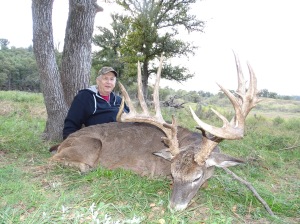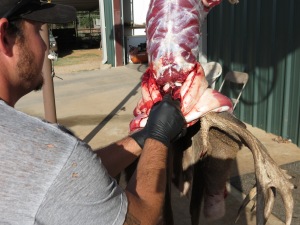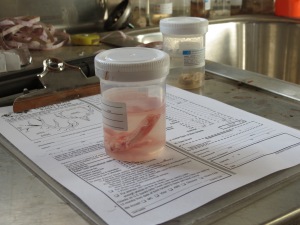Archive for January 2017

Like most people who hunt deer species in North America, I have a minimal knowledge of the disease known as CWD. Chronic Wasting Disease (CWD) is a fatal (to deer species) neurological disease. A misfolded protein called a prion causes the disease.
It passes from one deer to another through animal to animal contact. The shedding of prions through bodily fluids and/or the decay of infected animals creates a contaminated environment which allows the spread of the disease.
The disease does not pass along to humans or domestic livestock. But it can have a devastating effect on deer herds, especially if they are concentrated in a location such as those yarding up in winter and those in a breeding facility.
Biologists have tried numerous programs to limit the spread of the disease but as yet there is no known cure.
Most programs involve isolating infected areas and the sampling of brain tissue to find infected animals.
Last fall produced the harvest of the best deer of a 60-year hunting career. When told testing for CWD is required, anxiety set in. Visions of some college kid working for the game officials butchering the cape to get at the brain tissue came to the fold. Such was not the case.
Squaw Mountain Ranch where the deer was taken is also a deer breeding facility for sale of deer to ranches across Texas. In order to protect their property and herd, the ranch participates in a number of studies with the wildlife officials of the state. It is no near any of the areas where CWD has been found in the state and the hope to keep it that way.
Any deer that dies on this ranch is checked.
Concerns about damage to the cape are unwarranted. Watching the process turned out to be a good learning experience. Dusty, a guide on the ranch follows normal capeing procedures. However as the cape is rolled toward the head, an incision is made at the joining of the spinal column to the base of the brain.
With some specialized tools he is able to remove a two inch section of the spinal column. He places the sample in a container and sent out for testing. At the lab they section the sample and examine it under a microscope for any folded prions.
After two years of sampling every deer, this ranch has not found a single infected animal.



For many ducks and other waterfowl of the Mississippi Flyway, western Tennessee is a wintering location. They may leave occasionally but always seem to return. The duck migration is prominent but some geese are also present.
Late season includes teal (both blue and green-winged) ring-necks, shoveler, gadwall, widgeon, pintail, mallards and occasionally some Canada and speckled belly geese. Not all the species are there all the time. They move out and maybe travel to warmer areas for a few days only to return.
Waterfowl hunting is a major wintertime activity around Reelfoot Lake and area ponds and small lakes. They provide field, open water and pot-hole hunting. Area resorts and camps provide hunters with needs such as guide, blinds, and boat rentals.
Hunting continues until the end of January for all species. Special seasons for snow geese run until early March.
Born of the violent earthquakes of 1812-13, the lake and surrounding area consists of some thirty to fifty thousand square miles that underwent dramatic topographical changes visible today. During the quakes left sunken areas, fissures and land domes. The reversal of the flow of the Mississippi River flooded much of the area creating the lake as well as flat fertile land for agricultural purposes.
As the migrating flocks arrive the birds feed heavily on protein rich grains. They rest at night on large water areas for protection from predators. By day they move to the grain fields available in the area. Once they have rebuilt sufficient stocks of protein they turn to the invertebrates found in more shallow water areas including pot holes and ponds.
The birds hold in big water during colder air temperatures as the big water stays open longer and is not prone to freeze over.
When hunting small areas of water near large areas, the late season birds pitch out of the air and decoy easily. By watching live ducks, and how they react to other live ducks, one finds they the flocks are composed of even numbers of birds. This may mean that combined with their becoming so territorial, they have already paired up. They do not want to endure any harassment from other members of the flock.
Using this information, you may want to change your use of decoys in the small water. Try scaling back the decoy spread and constantly change it each day.
Waterfowl tend to be a little more active before weather fronts. A change in barometric pressure occurs right before the front comes in. Right after the front the pressure rises.
The birds become more active after a front passes because they can fly at higher altitudes. The hardest part of a duck’s exertion is the exhaling part. In high pressure situations birds can fly higher and it is easier on them to make long distance flights. The long distance flights make hunters want to pull their hair out. The hunting in any one given spot becomes hard.
Late season waterfowl hunting and calling is a constant case of analyzing what is going on with the birds. You may never figure it out completely but you might get a little bit closer.

Being cooped up for a couple of days due to weather is rather depressing. Today is clear but very cold. Coming home from the Post office I stopped about a half block away to view two adult bald eagles soaring over the house.
This is one of the nice things about January in southern Illinois. The waterfowl winter here on the refuge and the eagles have followed them on their migration as the clean-up crew. The eagles prey upon the sick and wounded birds as well as eating the dead ones. On sunny days the surface water of the lakes and ponds warm slightly attracting the carp. Eagles can spot the fish from far and swoop down upon them.
All along the Mississippi River Flyway various local groups have “Eagle Days” in which they promote the local economy by offering tours to view the birds.
Eagles are not strangers to this neighborhood. They sometimes sit on the ground in the back yard as they munch on some hapless small game animal. Today is a pleasure in that they are soaring around in a clear blue sky. They have moved off for now but they surely will come again another day.
In any event watching eagles go about their daily chores is a great way to push away the winter blues.

Bad weather in the form of ice and snow has caused cancelation of plans to attend Dallas Safari Club Show for this writer. But something good did come of staying inside for most of the day.
Serendipity resulted in accidentally coming upon an essay by Craig Boddington, world famous hunter and outdoor writer, about his philosophy of life as it relates to his career in hunting and writing about it.
It caused some reflection on this writer’s career in the hunting and fishing field. Although I usually like to keep my personal involvement out of the article, I am making an exception today.
The first commercial success occurred in the 4th grade when the prize for an essay on a local bank’s new signage produced the princely sum of $3. It would be about 15 years before the second sale came along.
That was about 50 years ago. In between I produced a lot of articles that did not sell as well as some freebees for law journals and social work magazines. I even edited an in-house journal for the social service department of a court system.
The real turning point came with a chance meeting at an outdoor show in Chicago. Gene Laulunen had just started MidWest Outdoors. At that time both he and his wife were still teaching school in the suburbs and put the magazine together on their kitchen table in the evening.
He was looking for someone to write about bowhunting. He had a writer on target archery and a friend had told him of me. I wrote a couple of pieces that appeared in the 3rd edition of MidWest Outdoors Magazine. I did not write any more for him for some long forgotten reason.
In the interim I did write some article for other magazines such as Archery World and Bowhunter. In the mid-70’s I became editor of a journal for the Illinois Chapter of Safari Club International and we contracted with MidWest Outdoors to print and distribute it on a monthly basis. Gene then encouraged me to get serious about writing about the outdoors.
Since then I have sold hundreds of article to him and to other publication throughout the upper Midwest.
In 1996 I retired from social work and corrections work. Six months later retirement became boring. I returned to writing, appearing in outdoor shows, a couple of videos and sponsorship of a youth goose hunting contest that occurs annually during National Hunting & Fishing Days.
I will turn 75 in a couple of months. Writing about hunting and fishing has opened a lot of doors. The field is well-known for a lot of freeloading. For that reason I have been reluctant to accept gifts of trips and gear. It just makes me uncomfortable. Most of my trips whether to Africa or around North America are paid for by me. If I do accept some hospitality in any form it is with the understanding that if it turns out to be a good trip, I will write about it. If not then I will not write anything about it. I do not do negative stories or reviews.
I have met, hunted with, fished with some of the greatest people in the outdoor industry. Many are gone now while the rest remain my friends for life.
In recent years health problems have caused me to cut back on some of my activities. It is heck getting old. Sitting here today has cause me to reflect on the past (a great time) and begin to set goals for 2017 that include more travel for hunting and fishing.
Those goals when accomplished will appear in this journal. Stay tuned!







